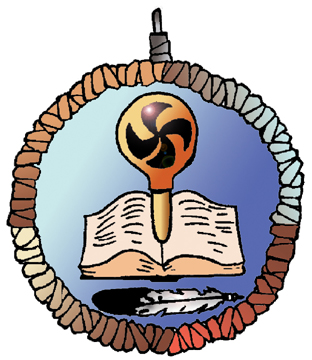|
|
Canku Ota |
|
|
(Many Paths) |
||
|
An Online Newsletter Celebrating Native America |
||
|
July 27, 2002 - Issue 66 |
||
|
|
||
|
Course Puts American Indian Heritage in Focus |
||
|
by Christine Millay Signs
on San Diego
|
||
|
|
 What
do you think of when the word "Indian" comes to mind? Are you
afraid of Indians? What if you hear the words "Native American?" What
do you think of when the word "Indian" comes to mind? Are you
afraid of Indians? What if you hear the words "Native American?"
While a camera filmed his every move, Lee Majel, 17, fired off those questions with the confidence of a professional journalist. For now, he is a high school student searching for information about his American Indian heritage and trying to determine the right path for his future. Lee's interview questions were part of the curriculum for the Young Native Scholars, a six-week summer program for 12 American Indian high school students. The course includes basic instruction in television and radio broadcasting, film production, Web-page design, music theory and the history of local indigenous cultures. "It sounded interesting because I don't know what I want to do later on in life," said Lee, who will be a senior at Valley Center High School this fall. Each student will earn three hours of college credit for completing the course. The program is sponsored by the University of California San Diego's American Indian Outreach program and several other groups, including the Southern California Tribal Chairman's Association. The association donated a van for students who need rides to and from class. Nine of the 12 students live on reservations in North County. The students meet for five hours Tuesdays and Thursdays on the UCSD campus in La Jolla or at the World Beat Center in Balboa Park. A majority of the class time – about 30 hours – is spent on film production. An additional 18 hours is devoted to learning about radio and television broadcasting, music theory and indigenous history. Two local experts are teaching the bulk of the program: Javier Francisco of the Media Arts Center in San Diego and Alan Lechuza, a composer and professor at UCSD. This is the second summer the university has offered the Young Native Scholars program, and the first time the curriculum has focused on multimedia training. This year's program, which ends July 30, is the brainchild of Marc Chavez, American Indian academic coordinator at UCSD, and Shonta Chaloux, site manager for the North County Community Resource Education and Youth Center. During a road trip last summer to several California universities, Chavez and Chaloux began talking about ways to help American Indian youth develop a voice by working with digital media. They said they hope the students use the skills they learn to launch multimedia projects, such as live Internet broadcasts of reservation news, that benefit their tribes. "We want to give them an option for self-empowerment using media as a social force," said Chavez, a 1994 graduate of UCSD. Eighteen reservations in the area are linked to a computer network capable of handling live Internet broadcasts, thanks to the Southern California Tribal Digital Village. The massive project, which has drastically expanded computer technology on the reservations, is being funded by a $5 million grant from Hewlett-Packard. Chavez said he hopes to form a self-sufficient media team to produce multimedia news broadcasts. The team would be available to document American Indian events throughout California and other states. The students learned the basics of filming while completing their first project – a mini documentary of teen-age life. The students had to write the story, film a video to match their words, and edit the video. They were trained to use miniature digital video cameras for filming and Macintosh computers for editing. One team created a story about a student who was caught with drugs at school. The film includes shots of a downtrodden teen walking alone down a long hallway to the principal's office to illustrate the emotion of the situation. Other scenes show the teen's disappointed parents and the police arriving at the school. "The hardest thing was getting the whole layout done," said Maurice Trudell, 17, an Oakland resident who is spending six weeks in San Diego for the program. Gary Rutledge, 14, the youngest student participating, said he wanted to enroll in the program because he knew nothing about video cameras. Gary said he is pleased that he will earn high school and college credit for completing the course. "It was either summer school or this," said Gary, who will be a freshman at Fallbrook High School in the fall. "I'd rather go here because it's all natives."
|
|
|
||
|
|
||
| Canku Ota is a free Newsletter celebrating Native America, its traditions and accomplishments . We do not provide subscriber or visitor names to anyone. Some articles presented in Canku Ota may contain copyright material. We have received appropriate permissions for republishing any articles. Material appearing here is distributed without profit or monetary gain to those who have expressed an interest. This is in accordance with Title 17 U.S.C. section 107. | ||
|
Canku Ota is a copyright © 2000, 2001, 2002 of Vicki Lockard and Paul Barry. |
||
 |
 |
|
|
The "Canku Ota - A Newsletter Celebrating Native America" web site and its design is the |
||
|
Copyright © 1999, 2000, 2001, 2002 of Paul C. Barry. |
||
|
All Rights Reserved. |
||